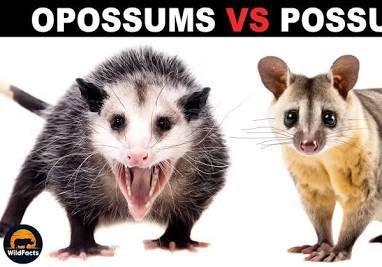I. Introduction: Clearing the Confusion About Possum vs Opossum
The terms possum and opossum are often used interchangeably, but these two marsupials are very different. This post explores possum vs opossum distinctions, including appearance, behaviour, and habitat, to clear up the confusion and highlight their ecological importance. Understanding these differences helps promote coexistence with these unique creatures and supports wildlife conservation efforts.
II. What’s in a Name? Etymology and Geography
A. Etymological Roots and Historical Missteps
The word opossum comes from the Powhatan language, first recorded by John Smith as “opassom” or “aposoum,” describing the North American marsupial. Centuries later, British naturalist Joseph Banks borrowed the shortened term possum for Australian marsupials, creating lasting confusion. In the U.S., especially in the South and Midwest, people often drop the “o” and call the Virginia opossum simply a possum, though opossum remains scientifically correct.
B. The Geographical Divide
- The Americas: Opossums belong to the order Didelphimorphia and are native to South, Central, and North America. The Virginia opossum (Didelphis virginiana) is the only species native to the United States and Canada.
- Australia & Nearby Islands: Possums are part of the suborder Phalangeriformes and are found exclusively in Australia, New Guinea, and surrounding islands. Australia has 27 species of possums and gliders.
III. The Virginia Opossum: North America’s Unique Marsupial
A. Physical Characteristics and Adaptations
Virginia opossums are easy to identify:
- Pointed snout, small dark eyes, long hairless tail
- Coarse, grayish-white fur
- Size: 4–14 pounds (1.8–6.3 kg), 2–3 feet long including tail
- Prehensile tail used for grasping branches (not for adult hanging)
- 50 teeth — more than any other North American land mammal
- Opposable, clawless thumbs on rear feet for climbing
Alt text: “Virginia opossum in North America – possum vs opossum”
B. The Truth About “Playing Possum”
The classic “playing dead” behavior is called tonic immobility. It’s an involuntary reaction to extreme fear. Opossums may become limp, secrete a foul odor, and appear lifeless for minutes to hours, deterring predators.
C. Diet, Disease Resistance, and Ecological Contributions
Virginia opossums are omnivores: insects, small rodents, fruits, vegetables, and carrion. Despite myths, rabies is rare due to their low body temperature. While once believed to eat thousands of ticks annually, recent studies show wild opossums do not regularly consume ticks.
D. Life in the Wild and Human Interaction
- Primarily nocturnal and solitary
- Lifespan: 1–2 years in the wild, up to 4 in captivity
- Attracted to urban areas for pet food, garbage, or fallen fruit
- Humane coexistence: secure trash bins, bring pet food indoors, seal home entry points
- Injured or orphaned opossums should be handled by licensed wildlife rehabilitators (NWF)
IV. Australian Possums: Diversity, Lifestyle, and Conservation
A. Distinctive Physical Characteristics
Australian possums differ significantly:
- Round face, shorter snout, large pointed ears
- Thick, soft fur (grey, brown, or golden)
- Thick, bushy tails
- Weight: 0.9–4 kg (tiny pygmy-possums to larger cuscuses)
- Large nocturnal eyes, some with gliding membranes
Alt text: “Australian brushtail possum climbing a tree – possum vs opossum”
B. Behavioural Differences
Unlike opossums, Australian possums do not play dead. They flee, hiss, growl, or defend themselves. Many are arboreal, with gliders capable of soaring long distances. Some species are social, like the Rock ringtail possum, while others are solitary.
C. Diet and Ecological Roles
Mostly herbivorous: leaves, flowers, fruit, tree sap. Specialized feeders include:
- Greater Glider: eucalypt leaves
- Honey Possum: nectar and pollen
- Striped Possum: probes for grubs with elongated finger
D. Conservation and Coexistence
Australian possums are legally protected (Australian Government Environment). For home intrusions:
- Use possum boxes
- Seal entry points
- Contact licensed professionals for removal
In New Zealand, the brushtail possum is invasive and threatens native flora and fauna.
V. Why Understanding Possum vs Opossum Matters
A. Conservation and Ecological Impact
Correct identification ensures proper conservation and ecosystem management. Opossums aid in scavenging, while protected Australian possums maintain biodiversity.
B. Human-Wildlife Coexistence
Knowing behavior differences prevents fear and promotes safe interaction. Urban management practices — securing food, sealing entry points — foster peaceful coexistence.
C. Dispelling Myths and Promoting Respect
Understanding these marsupials dispels myths, like the idea that all possums play dead or that opossums are rabies carriers. Appreciating their evolution, biology, and ecological roles encourages respect and protection.
VI. Conclusion: Appreciating Our Marsupial Neighbours
While possum and opossum sound similar, they are distinct marsupials with unique traits. The North American opossum is known for its rat-like tail and “playing dead” defense, while Australian possums are arboreal, bushy-tailed, and do not feign death. Recognizing these differences helps us coexist with, respect, and conserve these fascinating animals globally.
Internal links examples in text:
- For more on marsupials, see our guide to Australian wildlife and North American animals.
Outbound links examples in text:
- National Wildlife Federation – Virginia opossum
- Australian Government Environment – Australian possum conservation





